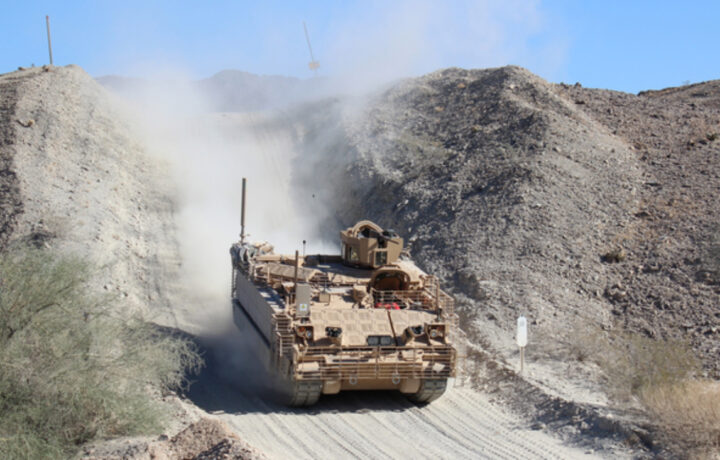This month, the United States Army awarded BAE System of York, PA, a full rate production contract for the Armored Multi-Purpose Vehicle (AMPV). The total award value for the initial vehicle order was $797 million, with additional options for a potential total contract amount of $1.6 billion.
This award will also make the first newly-designed and built tracked vehicle in the U.S. Army’s fleet to reach full-rate production in six decades.
“Entering full-rate production is a momentous milestone in the lifecycle of a production program for both the U.S. Army and BAE Systems,” said Jeremy Tondreault, president of the Platforms & Services sector at BAE Systems. “The AMPV is the next generation replacement for the venerable M113, and we are proud that this critical capability is on its way to the men and women who need our most capable combat vehicles on the front lines.”
Work on the AMPV program is taking place across BAE Systems’ industrial network, which includes facilities in Aiken, SC, Anniston, AL, Phoenix, AZ, Sterling Heights, MI, and York, PA.
Replacing the M113
The AMPV was designed to serve as a replacement for the M113 family of vehicles, which first entered service during the Vietnam War. Despite the fact that the platform has been in service for nearly six decades, the M113 currently comprises 30 percent of tracked vehicles within the U.S. Army’s Armored Brigade Combat Teams (ABCTs).
More than 80,000 M113 armored personnel carriers (APCs) have been produced, and it has been adopted by nations around the world. The United States Department of Defense (DoD) donated 200 of the platforms to Ukraine, while a number of NATO nations and other partners have since supplied M113s to aid Kyiv’s war effort.
The New AMPV
The new AMPV was also developed as a sub-project of the Next Generation Combat Vehicle program, and was meant to address the M113’s shortcomings in survivability and force protection; as well as mobility and power. It also features the ability to incorporate future technologies and the Army’s Network.
According to the Army, the AMPV shares a common powertrain and suspension with the M2 Bradley Infantry Fighting Vehicle and the M109A7 Paladin self-propelled howitzer, which will reduce logistical and mechanical burdens within ABCTs.
“Given the scope and scale of the M113 Family of Vehicles within the ABCT, the AMPV is a significant investment decision for the Army,” said Maj. Gen. Glenn Dean, Program Executive Officer for Ground Combat Systems. “The platform offers Soldiers better protection and survivability.”
The 1st Armored Brigade Combat Team, 3rd Infantry Division, was the first brigade to replace its M113s with AMPVs. The unit completed its training on the platform and received over 130 AMPVs to complete a full brigade set this past July.
A total of five variants of the AMPV have been developed, including a Mission Command vehicle, which was the first vehicle delivered to the military. It is already the cornerstone of the U.S. Army’s ABCT Network Modernization Strategy. It can facilitate a digital mission command center that is mobile while it can still take advantage of increased volume, protection, power, and cooling capabilities that are required with today’s advanced communications devices.
Unlike the older M113, the new AMPV will provide greater flexibility as four additional variants are being produced. These include:
*General Purpose vehicle – which could operate throughout the battle space to conduct resupply, maintenance, and alternate casualty evacuation from point of injury.
*Mortar Carrier – a variant that could provide immediate, and responsive, heavy mortar fire support to the ABCT in the conduct of fast-paced offensive operations.
*Medical Evacuation vehicle – a version that could enable immediate treatment or evacuation at the point of injury to either ambulatory or litter casualties.
*Medical Treatment vehicle – would be the first of its kind, serving as an ‘operating room on tracks’ for life-sustaining care to soldiers suffering from life-threatening injuries.
“The five variants of the AMPV will provide commanders with viable capabilities to maneuver across the full breadth of the ABCT battlefield,” Dean said.
Initial Low Rate Production
In 2014, BAE Systems was selected to produce the new vehicle to replace the more than 2,800 M113s in service. The first AMPV was handed over in a virtual “roll-off” ceremony at the BAE production line in York three years ago, on September 9, 2023.
However, delivery of the first AMPV had been delayed due to the Covid-19 pandemic.
The program had entered low-rate initial production (LRIP) in January 2019, and BAE Systems was originally awarded in 2018, is for more than 450 vehicles.
Full-Rate Production
The U.S. Army said that it is using a multi-phased approach to develop, produce, and field the AMPV. The service has received over 276 of the approximately 450 vehicles to be delivered by the end of 2024, and the Army will start receiving delivery of the full rate production vehicles the beginning of 2025.
The AMPV is one of the Army’s top 35 modernization priorities, fulfilling the Army’s strategy of protection, mobility, reliability and interoperability. The Army’s worldwide AMPV fleet will include nearly 3,000 vehicles delivered within the next 20 years.




